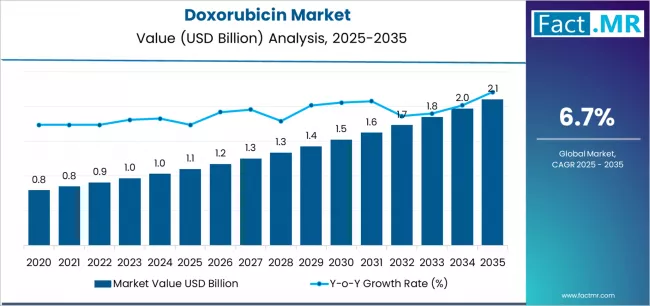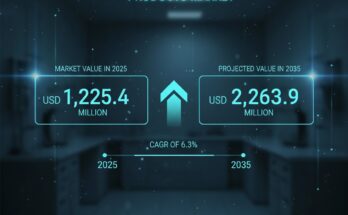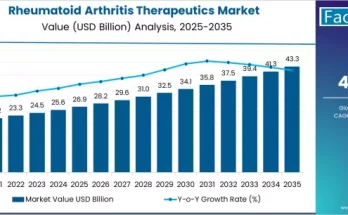The global doxorubicin market is set for strong expansion over the next decade, propelled by the rising global cancer burden, advancements in targeted drug delivery systems, and increased adoption of combination chemotherapy therapies. According to a recent analysis by Fact.MR, the market is projected to grow from USD 1.1 billion in 2025 to USD 2.1 billion by 2035, reflecting a robust CAGR of 6.7% and an absolute growth of USD 1.0 billion during the forecast period.
Doxorubicin—one of the most widely used anthracycline chemotherapeutic agents—continues to play a crucial role in managing various cancers, including breast cancer, leukemia, lymphoma, sarcoma, and ovarian cancer. Increasing emphasis on liposomal formulations, reduced toxicity profiles, and personalized oncology therapies is shaping the future of the market.
Strategic Market Drivers
Growing Global Cancer Incidence Elevates Demand
The rising prevalence of cancer worldwide is the primary driver accelerating the adoption of doxorubicin-based treatments. With breast cancer, sarcomas, and hematological malignancies witnessing significant growth, doxorubicin remains a mainstay of first-line and combination therapies. The drug’s proven efficacy across multiple tumor types continues to reinforce its clinical relevance.
Advancements in Liposomal & Targeted Delivery Systems
Emerging liposomal, pegylated, and nanoparticle-based formulations are improving doxorubicin’s therapeutic index by reducing cardiotoxicity and enhancing tumor targeting. These innovations are expanding usage among elderly and high-risk patient groups while supporting the push toward precision oncology.
Expansion of Hospital & Specialty Oncology Care Infrastructure
Globally expanding cancer care networks—including specialty oncology centers, infusion clinics, and hospital pharmacies—are strengthening drug accessibility. Improved healthcare reimbursement, supportive government cancer programs, and rising oncology awareness are boosting market penetration.
Combination Therapy Adoption Boosts Usage
Doxorubicin’s compatibility with advanced agents such as targeted therapies, immunotherapy drugs, and hormone treatments is fueling increased adoption. Combination regimens—especially for breast cancer and lymphoma—continue to deliver improved survival outcomes and expand treatment applicability.
Browse Full Report: https://www.factmr.com/report/doxorubicin-market
Regional Growth Highlights
North America: Leading with Oncology Innovation
North America dominates the doxorubicin market owing to advanced cancer treatment infrastructure, high diagnosis rates, strong R&D investment, and widespread adoption of novel drug-delivery formulations. The U.S. continues to lead in liposomal doxorubicin research and clinical trials.
Europe: Strong Clinical Adoption and Regulatory Backing
Europe’s growing emphasis on clinical oncology guidelines, pharmaceutical innovation, and patient access programs supports high doxorubicin consumption. Countries such as Germany, France, and the U.K. demonstrate strong demand for both branded and generic formulations.
East Asia: Rapid Healthcare Expansion & Rising Cancer Detection
China, Japan, and South Korea are experiencing a surge in cancer cases and rapid improvement in diagnostic capabilities. Increased healthcare spending, oncology-focused hospital expansion, and greater acceptance of combination regimens are accelerating regional growth.
Emerging Markets: Growing Opportunities in Cancer Treatment Access
India, Brazil, Mexico, Southeast Asia, and Middle Eastern countries are witnessing rising cancer awareness, expanding insurance coverage, and improved access to chemotherapy drugs—boosting demand for both conventional and liposomal doxorubicin products.
Market Segmentation Insights
By Formulation
- Conventional Doxorubicin – Widely used and cost-effective.
- Liposomal Doxorubicin – Fastest-growing due to reduced toxicity and enhanced targeting.
- Pegylated Liposomal Doxorubicin (PLD) – Premium segment driven by extended circulation time.
By Application
- Breast Cancer – Largest application segment.
- Leukemia & Lymphoma – Strong demand from hematologic oncology.
- Sarcoma – Significant usage in soft-tissue treatment regimens.
- Ovarian & Other Cancers – Expanding due to combination therapy adoption.
By Distribution Channel
- Hospital Pharmacies – Dominant channel due to controlled administration settings.
- Specialty Oncology Centers – Growing importance with rising cancer burden.
- Retail & Online Pharmacies – Increasing access to generics in emerging markets.
Challenges Impacting Market Growth
- Cardiotoxicity Risks – Long-term heart-related side effects limit repeated dosing.
- High Costs of Advanced Formulations – Liposomal variants are significantly more expensive than generics.
- Strict Regulatory Requirements – Oncology drug approvals demand extensive clinical validation.
- Competition from Emerging Targeted Therapies – Immunotherapy and biologics are expanding rapidly.
Competitive Landscape
The doxorubicin market is moderately competitive, with global and regional players focusing on improved drug delivery, oncology partnerships, and portfolio expansion.
Key Companies Profiled
- Pfizer Inc.
- Novartis AG
- Sun Pharmaceutical Industries
- Johnson & Johnson
- Teva Pharmaceutical Industries
- Dr. Reddy’s Laboratories
- Baxter International
- Mylan N.V. (Viatris)
- Cipla Ltd.
- Zydus Lifesciences
Manufacturers are investing in:
- Liposomal and nanoparticle delivery systems
- Reduced-toxicity formulations
- Advanced oncology manufacturing facilities
- Affordable generics for emerging markets
Recent Developments
2024: Global pharmaceutical companies accelerated trials on next-generation liposomal and nanoparticle doxorubicin formulations to minimize cardiotoxicity.
2023: Rapid expansion of generic doxorubicin manufacturing across India, China, and Southeast Asia enhanced global availability.
2022: New clinical studies supported the efficacy of doxorubicin in combination with immunotherapy agents for breast cancer and sarcoma.
Future Outlook: A Decade of Innovation in Oncology Treatment
The next decade will reshape the doxorubicin market through advanced drug delivery technologies, personalized cancer therapies, and improved patient safety profiles. Demand will further rise as global cancer incidence continues to climb and healthcare systems strengthen early diagnosis and treatment infrastructure.
With growing adoption across mainstream oncology care and precision medicine pathways, the doxorubicin market is poised for nearly 1.9x growth by 2035, establishing itself as a critical component of global cancer treatment.



